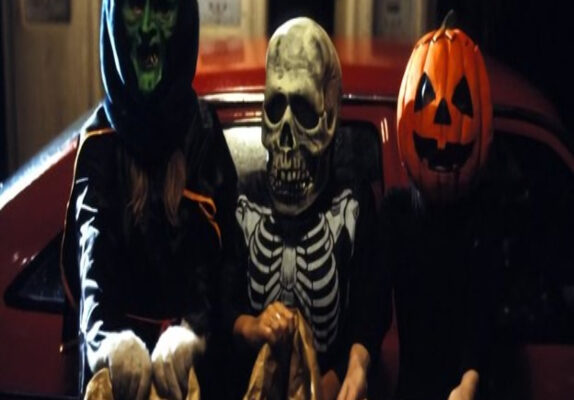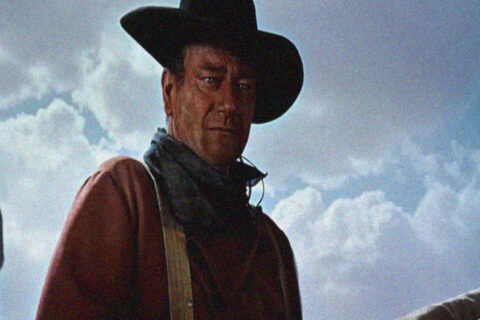The Halloween series, if nothing else, is consistent. While the other two of the “Big Three” of 1980s horror franchises went through major shifts throughout their respective series – Jason Voorhees went from a kid at the bottom of Crystal Lake to a hermit to an indestructible zombie, and Freddy Krueger devolved from gallows humor to a Looney Toon. The Halloween series, although varying drastically in terms of quality, did not go through any major shifts in tone or the basic outline of its antagonist. Michael Myers has pretty much remained the same as he was in 1978.
But there is one exception to this rule – the third film of the series, Halloween III: Season of the Witch. Rather than being just another attempt to recapture the magic of the original, the film jettisons the Michael Myers storyline all together in favor of one that touches upon Celtic mythology: Tom Atkins stars as Dr. Dan Challis, an ER doctor, who stumbles upon a plot by evil Irish businessman Conal Cochran (played by Dan O’Herlihy) who plans to kill millions of children on Halloween night via Halloween masks made by his company, Silver Shamrock, that can turn them into a pile of bugs and snakes. The masks are being powered by a stolen piece of Stonehenge and is part of a pagan sacrifice. That short synopsis only scratches the surface of how bonkers, and wonderful, this movie is. It’s my second favorite film of the series at this point.
When the film came out in 1982, it was supposed to be the beginning of a new direction for the franchise. John Carpenter (correctly) realized that the Michael Myers storyline had gone as far as it could, and the series needed to move on. The plan was to release a different yearly film based on the idea of Halloween, each unrelated to the last. But audiences hated this film, they wanted to see Michael Myers again. The film flopped and, as a result, another Halloween film would not be made until 1988, and this time Michael would be back. Halloween III quickly became the black sheep of the franchise – the worst of the series and a film that was best forgotten. The movie had a few defenders, but they were in a distinct minority.
And that’s how it would last until around 2010 when, all of a sudden, more and more people began to reappraise the film; it quickly went from the worst of the series to an underrated gem to the best Halloween film other than the original. The purpose of this essay will not be so much to review the film itself, as much as I like it, but rather to examine why this film went through such a rapid reappraisal almost 30 years after its release. To sum it up succinctly, Halloween III offers a remarkably accurate depiction of contemporary life in the United States – in other words, the audience finally caught up with this film.
This can be particularly observed in its depiction of the surveillance state and the merger of government and corporate power. Santa Mira, a fictional small town in northern California where the Silver Shamrock company is based, has become a surveillance nightmare. Cameras constantly patrol the town, and the movement of the citizens is under strict control. Though Silver Shamrock is a private company, it has become the functional government of the town. Parallels between the state of Santa Mira and the United States today are easy enough to spot. The security state that emerged in the days after 9/11 have now been in place for a generation. There are now millions of adults who know nothing but the world of the Patriot Act, something that was initially sold as way of combatting Islamic terrorists, but has been increasingly turned against American citizens, and even more so rightwing Whites. As the pre-9/11 world recedes more and more into distant memory, the world of Halloween III appears to be less and less far-fetched.
In the film, Silver Shamrock is one of the biggest companies in the country. Conal Cochran is mentioned as one of the wealthiest men in the United States, while their masks are considered the “must have” item for Halloween with their commercials constantly playing. Despite all this, the native population of Santa Mira has gained nothing. Rather than hiring locals, Conal Cochran moved his own people into the town. Sound familiar? Once again, the United States has become Santa Mira. We have had years of rosy macroeconomic numbers, the ones that politicians love to tout, provided their wing of the uniparty is in power. But the average person knows better, they’ve been suffering from declining economic conditions for years. It’s often stated that the American dream is for one’s own children to be better off than themselves. The corollary to that is the children must become better off than their own parents. But for millions, both the American dream and its resulting corollary, are just that – dreams that will never come true. And more to the direct point, economic growth is becoming heavily concentrated in the hands of the foreign born. Virtually all the job growth post-Covid has gone to immigrants. The United States has ceased to become a nation, or more correctly an alliance of nations (see Colin Woodard’s fantastic American Nations for more on this), but rather an economic zone.
And then there is the utter ubiquitously advertising. The Silver Shamrock commercial is constantly played, giving the viewer a sense that the company and its influences are inescapable. The constant advertisement today almost feels similar. The power of the Silver Shamrock commercial over children is truly frightening to witness as it causes them to act against themselves. Like in the film, millions of children have essentially been lined up to become literal pagan sacrifices thanks to secretive corporations. They might not become piles of bugs and snakes, but they have gone through life-altering medical “treatments” because the medical-industrial complex wants a steady supply of customers. But even beyond transgenderism, we are watching children essentially being sacrificed – even leftwing teachers I’ve conversed with utterly hate TikTok, knowing that much of the bad behavior they must deal with has its origins in a TikTok video. Once again, Halloween III no longer appears to be all that outlandish.
I do consider what happened to Halloween III to be a shame. Granted, I know that no one in 1982 had a crystal ball and could not predict just how beaten into the ground the Michael Myers storyline would become, but all the same, I do think that the decade would have turned out better had Halloween III been a hit and the filmmakers could have move forward with their original plan for the series. At the very least, the decade may have had a little more variety. I am pleased to see how this film’s reputation has been transformed, even if it is because the nightmarish scenario presented has become realized in the contemporary United States in many horrifying ways.







Thank you for this article! I love Halloween 3 and try to watch it every Halloween along with the original. I really enjoyed reading your previous articles on Charles B Pierce. I recently ordered The Town that Shredded Sundown and cannot wait to watch it. I hope you post more film content, especially hidden gems from Southern directors/producers/writers.
Check out “Absence of Malice” with Paul Newman. It’s about the lying press, with some critique of feminism as well.